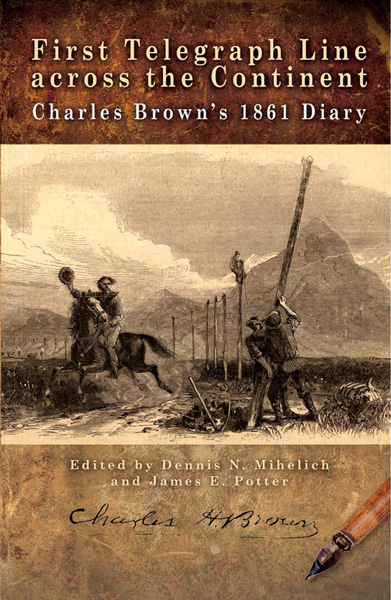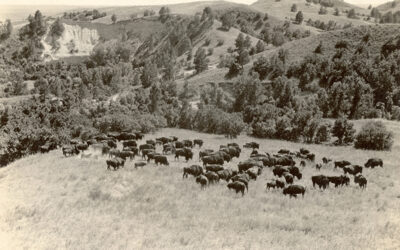 The transcontinental telegraph was a remarkable technological feat that had major consequences for the West and the nation as a whole. Yet relatively little has been written about it. Historians Dennis N. Mihelich and James E. Potter have edited First Telegraph Line across the Continent: Charles Brown’s 1861 Diary, published by the Nebraska State Historical Society. Recently re-discovered in the Smithsonian Institution collections, this previously unpublished diary is the only known extensive source written about the day-to-day construction of one segment of the first transcontinental telegraph line. Like the transcontinental railroad several years later, the telegraph line was built by two companies, one working west from Omaha, Nebraska, and one working east from California. The Omaha company was headed by Edward Creighton, a prominent businessman best remembered today as the namesake of Creighton University. As Creighton’s assistant, Brown wrote about events along a portion of the route. His diary, which begins in Julesburg, Colorado, and ends in central Wyoming, covers events in places such as Chimney Rock, Scotts Bluff, and Fort Laramie, and points farther east such as Fort Kearny (near present-day Kearney, Neb.). Brown’s lively narrative is filled with period detail about individuals, road ranches, attitudes toward Indians, public promotion of the spirit of Manifest Destiny, difficulties facing construction crews, the nature of frontier law enforcement, and even the issues of secession and Civil War. Dennis N. Mihelich is a retired professor of history from Creighton University; James E. Potter is Senior Research Historian at the Nebraska State Historical Society.
The transcontinental telegraph was a remarkable technological feat that had major consequences for the West and the nation as a whole. Yet relatively little has been written about it. Historians Dennis N. Mihelich and James E. Potter have edited First Telegraph Line across the Continent: Charles Brown’s 1861 Diary, published by the Nebraska State Historical Society. Recently re-discovered in the Smithsonian Institution collections, this previously unpublished diary is the only known extensive source written about the day-to-day construction of one segment of the first transcontinental telegraph line. Like the transcontinental railroad several years later, the telegraph line was built by two companies, one working west from Omaha, Nebraska, and one working east from California. The Omaha company was headed by Edward Creighton, a prominent businessman best remembered today as the namesake of Creighton University. As Creighton’s assistant, Brown wrote about events along a portion of the route. His diary, which begins in Julesburg, Colorado, and ends in central Wyoming, covers events in places such as Chimney Rock, Scotts Bluff, and Fort Laramie, and points farther east such as Fort Kearny (near present-day Kearney, Neb.). Brown’s lively narrative is filled with period detail about individuals, road ranches, attitudes toward Indians, public promotion of the spirit of Manifest Destiny, difficulties facing construction crews, the nature of frontier law enforcement, and even the issues of secession and Civil War. Dennis N. Mihelich is a retired professor of history from Creighton University; James E. Potter is Senior Research Historian at the Nebraska State Historical Society.
“Brown’s perception, insights and lively style make this a great narrative.” —John D. McDermott, author of Guardians of the Pacific Telegraph and many books on the western experience
First Telegraph Line across the Continent: Charles Brown’s 1861 Diary Edited by Dennis N. Mihelich and James E. Potter $14.95 / NSHS Members $13.46 (plus tax & shipping) Softcover, 133 pages, illustrated, with introduction, epilogue, index, and bibliography. Publication of this book was made possible by The Ronald K. and Judith M. Stolz Parks Publishing Fund established at the Nebraska State Historical Society Foundation (History Nebraska Foundation), and use of this Fund for this purpose is made in memory of Wayne Kemper Parks (1909-1995) and Hazel Virginia Hill Parks (1911-1991), lifelong Nebraskans who were born on Madison County farms, were married on March 19, 1930, and were farmers in Madison and Pierce counties.
(Updated 8/16/2023)



